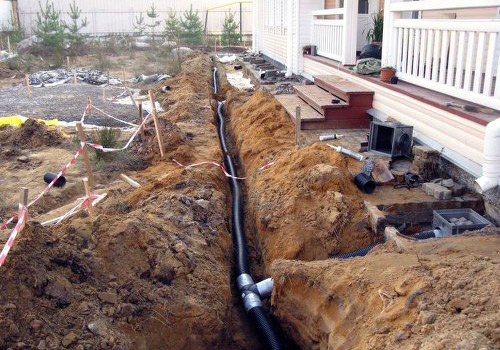How to calculate the drainage system
- What should be taken into account when calculating drainage?
- How to calculate the drainage system?
The backyard gives you the opportunity to spend time outdoors, grow vegetables for your own table and perform many other tasks. All this makes life in a country house attractive and comfortable. But the full use of a personal plot is impossible without competent drainage. Garden crops and many ornamental crops do not grow well on waterlogged or excessively moist soil after rains, outbuildings quickly collapse and rot, cellars and basements are flooded with groundwater.
Figure 1. Map of the depth of soil freezing.
How to calculate the drainage system?
Figure 3. Scheme of the drainage system.
- the depth of laying pipes is calculated from the depth of freezing and the depth of the foundation. The pipeline must be located below the maximum freezing level of the soil in order to prevent clogging of the pipes with ice by the time of mass snowmelt in the spring. Approximate values are shown in fig. 1. Due to the laying of drainage pipes in a porous permeable layer of sand or gravel, which freezes much less, it is possible to reduce the required depth by 30 cm or 50 cm. Rice. 2;
- to perform a calculation on the depth of the foundation, it must be taken into account that for successful drainage from its base, drains must pass at least 50 cm deeper than it;
- the distance from the foundation to the wall drainage pipes should not be less than 3 m. This factor will affect the calculation of the total length of the pipeline, the number of pipes required and the length of the trenches for their laying;
- The calculation of the elevation difference when determining the slope is made by the formula: N = xC, where L & the total length of the pipeline for a given collector, N & the elevation difference for a value of 1% slope, C & the number of slope percentages.
For example, the length of the drainage system along the perimeter of the house is 100 m, the flow occurs through parallel drains into a common collector. Then the length of the pipes from the top point to the well is 50 m, the required slope & 1%. Substituting the values into the formula, we get a height difference between the beginning of the system and the water discharge point of 50 cm.
If you make 2 collectors at the corners of the house, it is possible to significantly reduce earthwork, since the length of each branch will be only 25 m, requiring a height difference of only 25 cm.
The depth of the trench at the top point is determined based on the depth of freezing, the required thickness of the drainage layer and the depth of the foundation, sequentially adding digital values. To determine the depth of the trench at the point of discharge, the value of the height difference is also summed up.
To achieve the best result, a specialist of the appropriate profile should be involved in the calculation of the drainage system.
But even approximately the calculations made will give a complete picture of the amount of work required and the amount of materials for their implementation.
Drainage systems
In terms of depth, the following types of drainage systems are distinguished:
Table 1
| Features of functioning | Types of drainage systems | |
| To ensure deep drainage | To provide surface drainage | |
| period of effective work | operates all year round | operates during the warm season |
| trench depth | from 1.5 m | from 0.7 m |
| function | allow to exclude waterlogging of the soil due to precipitation | allow to significantly lower the values of the groundwater level |
| the presence of a leveling sand layer | 5 cm | 5 cm |
| the value of the section of the crushed stone layer in the geotextile material around the drains | 40x40 | 40x40 |
| the presence of backfilling of trenches with sand | available | available |
| drain length calculation | 1 linear meter of drainage provides water collection from 8-9 m2 of land on clay soils and from 13-14 m2 on sandy soils | 1 linear meter of drainage provides water collection from 8-9 m2 of land on clay soils and from 13-14 m2 on sandy soils |
| the need for a collector and pumping station | not required | required |
From the point of view of the design features of drainage, there are:
horizontal drainage, which is a system of pipes (drains). Drainage wells are being built for their maintenance;
vertical drainage, consisting of a system of drainage wells, united by a collector, from which water is pumped out by means of pumps;
combined drainage, combining elements of vertical and horizontal systems.
Drainage wells
By means of drainage wells placed in the zones of rotation of drainage pipes, moisture is collected, the direction for its removal is set, and the pipeline is serviced.
Drains (pipes)
The key component of the drainage system are drains made of polymer, composite, asbestos-cement, geotextile or ceramic materials with filtering properties (properties to pass only moisture, but prevent soil from entering the pipes).
It is most optimal to use modern composite and polymeric materials for the manufacture of drains. Unlike asbestos-cement and ceramic, such pipes do not require pre-treatment (cuts and holes), filter sleeves, protection of butt joints.
Drainage and drainage scheme
Taking into account the above characteristics, the choice of the type of drainage system is made, which can be surface, vertical and deep. Surface drainage performs the function of draining rain and melt water from the surface of the site
It is not difficult to design and install such a system. Since the drains are located on the surface, there is no need to calculate the depth of drainage, respectively, and the volume of excavation is insignificant.
Surface drainage performs the function of removing rain and melt water from the surface of the site. It is not difficult to design and install such a system. Since the drains are located on the surface, it is not necessary to calculate the drainage depth, and, accordingly, the amount of excavation is insignificant.
Vertical drainage is a system of drainage wells located in places where moisture accumulates the most. The collected water is discharged either into the lower layers of the soil, or pumped out using pumping equipment.
The deep system is most efficient, since it allows you to protect the territory from almost all sources of water supply. It is a network of drainage pipes, which are located at a certain depth. Such drainage is often used to protect foundations and basements, as well as the garden area from ground and ground-pressure supply.
Drainage
Not all owners of country houses are aware of the importance of building a drainage system. Meanwhile, groundwater can cause significant damage to both buildings and plants growing on the site.
The following factors can indicate the possible occurrence of problems associated with groundwater:
- Neighboring houses are built without cellars.
- Owners of houses with basements or cellars on the territory complain about the ingress of water into these buildings.
- Swamp plants grow on the site, such as cattail.
The absence of the above factors does not guarantee that groundwater problems will never occur on your site. To calculate the drainage system, it is necessary to find out the geological characteristics of the site: the structure and characteristics of the soil, the level of groundwater occurrence depending on the season, the volume of water that falls in the area in the form of precipitation and flood waters. To obtain the necessary information, you should send a request to the department of land resources of the district.


